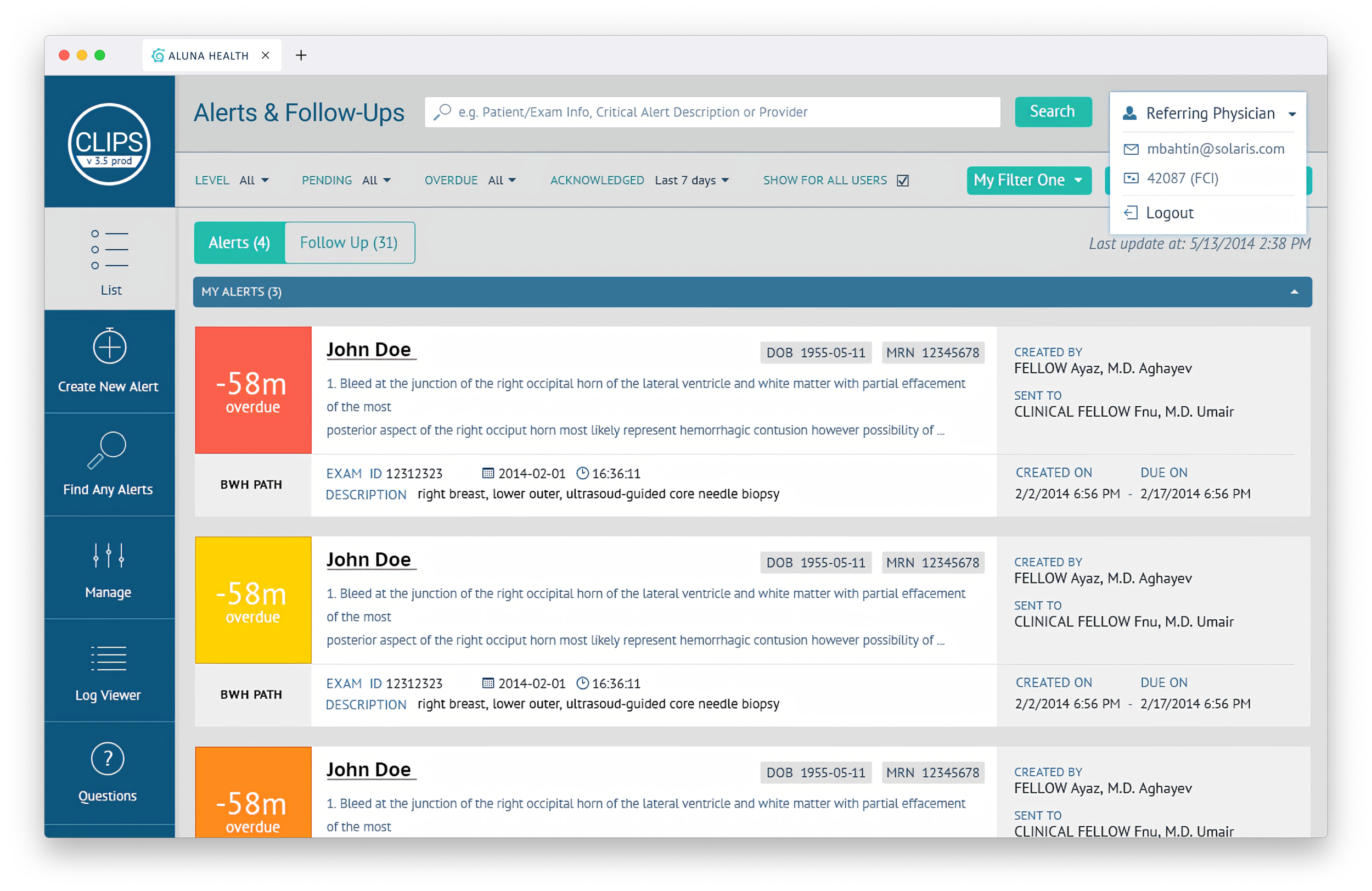CLIPS
Closing the Loop Improves Patient Safety
Aluna CLIPS (Closing the Loop Improves Patient Safety) is a closed loop communication tool with associated notification, escalation, tracking and monitoring capabilities. It is a secure web-enabled application engineered and supported by Aluna Health with intellectual property owned by Mass General Brigham. In MGB, CLIPS, aka ANCR is currently implemented across several departments.
Being integrated in EHR (Epic), CLIPS software includes Data Extraction and Clinical Decision Support algorithms. Physician-oriented UI supports an input of incidental findings by clinician (radiologist), as well as a choice of possible procedures. CLIPS may be connected with Knowledge Library, as well as with Patient Overview. The last is another Aluna applications, which performs chart abstraction, data summarisation and visualisation of patient's full medical history.
CLIPS support various communication channels and performs follow ups execution management by automated verification of procedures completion and generation of additional notifications/requests as needed.
Features
Critical Test Results Communications
- Secure notifications and rich transport support
CLIPS supports e-mail, texting, paging, direct messaging out of the box in a HIPAA compliant way. It also has a mechanism to plug-in any transport, including external systems API calls. - Alert tracking and escalation
Reminders and escalation procedures can be configured based on the critical alert level - EMR/PACS/CPOE integration
CLIPS can be launched directly from the clinical system passing patient context and other relevant data. It uses SSO and can be integrated with enterprise user directory. - Multimodal
CLIPS has both Desktop and Mobile versions allowing react on notifications using any device.
Follow-up Management
- Follow-up scheduling and notifications
CLIPS has built-in order scheduling capabilities and integrates with scheduling software / systems. - Built-in decision support system
Choosing the right follow-up procedure or critical alert level based on the patient data and lab results retrieved from the EMR or other clinical systems (PACS, CPOE, etc.) - Collaborative follow-up plans between a radiologist and referring provider
Referring provider can suggest modifications to the proposed follow-up procedure and send back to radiologist and/or scheduling department. - Automatic Follow-up Tracking
CLIPS is integrated with RIS to retrieve information about already done follow-ups.
Peer Learning System
- Secure feedback from receiver to sender
Feedback process is built into alert and follow-up management workflows. - Integrated with image viewing software
CLIPS launches image viewing software in context based on the alert details. - Rich analytics
Quality dashboard provide rich performance statistics.
References
- Lacson R, O’Connor SD, Andriole KP, Prevedello LM, Khorasani R. Automated critical test result notification system: architecture, design, and assessment of provider satisfaction. AJR Am J Roentgenol 2014;203(5):W491-496.
- Lacson R, Prevedello LM, Andriole KP, et al. Four-year impact of an alert notification system on closed loop communication of critical test results. AJR Am J Roentgenol 2014;203(5):933–8.
- Gupta A, Lacson R, Balthazar PC, Haq S, Landman AB, Khorasani R. Assessing Documentation of Critical Imaging Result Follow-up Recommendations in Emergency Department Discharge Instructions. J Digit Imaging 2017;1–6.
- Lacson R, O’Connor SD, Sahni VA, et al. Impact of an electronic alert notification system embedded in radiologists’ workflow on closed-loop communication of critical results: a time series analysis. BMJ Qual Saf 2016;25(7):518–24.
- O’Connor SD, Khorasani R, Pochebit SM, Lacson R, Andriole KP, Dalal AK. Semiautomated System for Nonurgent, Clinically Significant Pathology Results. Appl Clin Inform 2018;9(2):411–21.
- Roy CL, Rothschild JM, Dighe AS, et al. An initiative to improve the management of clinically significant test results in a large health care network. Jt Comm J Qual Patient Saf Jt Comm Resour 2013;39(11):517– 27.
- Trinh TW, Boland GW, Khorasani R. Improving radiology peer learning: comparing a novel electronic peer learning tool and a traditional score-based peer review system. AJR Am J Roentgenol 2019;212(1):135–41. 8. Trinh TW, Shinagare AB, Khorasani R. Yield of Learning Opportunities From a Radiology Random Peer Review Program. AJR Am J Roentgenol 2018;211(3):630–4.
- Hammer MM, Kapoor N, Desai SP, et al. Adoption of a Closed-Loop Communication Tool to Establish and Execute a Collaborative Follow-Up Plan for Incidental Pulmonary Nodules. Am J Roentgenol 2019;1–5.
- Kapoor N, Lacson R, Hammer M, et al. Physician Agreement With Recommendations Contained in a National Guideline for the Management of Incidental Pulmonary Nodules: A Case Study. J Am Coll Radiol 2020;S1546144020307791.
- Giess CS, Wang A, Frost EP, Chikarmane SA, Boland GW, Khorasani R. Impact of an Information Technology-Enabled Quality Improvement Initiative on Timeliness of Patient Contact and Scheduling of Screening Mammography Recall. AJR Am J Roentgenol 2019;1–6.








